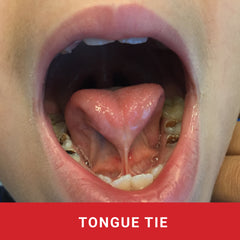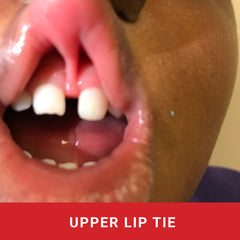WHAT I HAVE LEARNED AS A PEDIATRIC EAR, NOSE AND THROAT SURGEON
Despite 4 years of medical school, followed by 5 years of otolaryngology (ear, nose and throat) residency training, and 2 more years of fellowship training to become a Pediatric ENT, I never received any formal training on the subject of tongue tie, lip tie, or the relationship between either and breastfeeding. I am not a lactation specialist or speech therapist. However, I am a mother who met with 3 lactation specialists at the hospital before going home. Each were kind, had good intentions and were quite passionate, but they had different suggestions.
My newborn made me feel like my nipple got slammed in the car door every time she was nursing. I struggled to nurse unsuccessfully the first 8 weeks, and was only able to give breast milk by pumping every feeding into a bottle. The only bottle that worked for her was one that was a decoration on one of three diaper cakes. I cried daily, and will never forget the one night when, during pumping, I accidentally spilled the less than 1oz in the bottle, which I treated as “liquid gold” and the only life preserver in the open sea. My husband watched helplessly and was not sure what to do. Yes, I even had to supplement with formula a few times, despite being told by one lactation specialist that I would be breaking the “golden seal” of her gut and ruin her forever.
Claire is now 12 years-old, a high achieving student and a good little golfer. Surely, it’s all because of my not giving up, nursing her until 10 months of age with breastmilk that I pumped between tonsillectomy surgeries after returning to work full time 9 weeks postpartum. This is why I write this blog. I know how hard it’s been for you, even if other doctors don’t.
I will share with you what I have learned based on caring for hundreds of infants and children of all ages, and having performed “lingual frenotomy” or tongue-tie release and (rarely) lip tie release both as office procedures for newborns and in the operating room for older children. I have also learned so much from conversations with mothers who have struggled to nurse, watching them nurse before and after releasing a tongue tie, and teaching myself the various factors that influence successful latching and nursing, including a mother’s nipple anatomy. That’s right, I said it. Sounds creepy. I assure you medical students, residents and most doctors do not routinely examine a woman while she is trying to nurse. I am so thankful that I am a mother and physician who has learned so much from my patients and families.
Of all the medical publications I have ever written, I sincerely hope this blog will be the most widely read and reach millions of mothers. I want you to know what doctors may not know, because they too may not have been trained or taught about breastfeeding.
Since moving to Orlando, Florida in June 2013 to work at a new children’s hospital, I have become the “expert.” Many of my partners make fun of me in jest; the male partners frankly don’t feel all that comfortable about the topic of breastfeeding, even if their own wives nursed their children. Thanks to social media, “tongue tie/lip tie” and other “ties” became an "epidemic" about 4 - 5 years ago across the U.S. In January 2018. I was at a national meeting and attended a panel of several highly reputable colleagues from large academic medical centers and metropolitan cities, sharing research evidence on this topic as well as what they are experiencing in their practices across the U.S. I spent last year and most of this year having a “special” clinic just for tongue tie and nursing difficulty, and these slots were full as soon as I opened them. I’m grateful to have become as comfortable as I am on this topic, learning from babies that I did not “cut” when I didn’t think they needed it and saw them again when they were older. So, as I reflected on the past 5. 5 years, here is what I’ve learned:
WHAT IS TONGUE TIE/LIP TIE?
It is normal for everyone to have a “tie” or frenulum: one under the tongue and one attaching the upper lip to the gum of the upper teeth (maxilla). I often imagine someone driving with their head out of the car window and picture lips flopping in the wind all over the place if we had no “ties” at all.
Tongue Tie: Some infants are born with an excessive band of tissue that may prevent the tongue from being completely free to move around the mouth (see photo below). The tongue is a powerful muscle, but it can’t suck and draw milk out of the breast if it’s not fully underneath the nipple.
Upper Lip Tie: Thick excessive “lip tie” is a band that extends down from inside the upper lip all the way to the edge of the upper gum, and may even wrap around the gum (see photo below). Short or thick upper lip tie may prevent the upper lip from “everting” or “flipping outward” when one puckers. Most of the time I find the upper lip is just fine and does not need to be “released.” Just because the upper lip doesn’t “flare out” does not mean your baby can’t latch; it’s variable, not black and white.
Side/Cheek Ties: I won’t comment on “side” or cheek ties. Excluding tongue and lip ties, I would not advise cutting any other ties, anywhere.
Not all pediatricians, nor doctors, know what a tongue or lip tie is. Doctors may not check under the tongue and therefore miss even the most obvious tongue ties. Of course, there are many doctors who do and will likely refer you to a specialist sooner rather than later because he/she also wants to support you to breastfeed successfully. The same is true for lactation specialists. They are often the ones who refer patients to me (a Pediatric ENT) and for that I am always grateful because I can’t help if I never get to meet you. 

HOW DO I KNOW IF MY BABY HAS A TONGUE TIE?
Mothers may be told their newborn doesn’t have tongue tie, even when they do.
If you are wondering if your infant/baby has it, gently sweep under your infant’s tongue using a clean pinky finger. If you hit a “bump” or tight band, or you can see that it looks like there is a white/pale “band of tissue” between the underside of the tongue and the floor of mouth, that’s a tongue tie.
WHAT IS THE DIFFERENCE BETWEEN “ANTERIOR” AND “POSTERIOR” TONGUE TIES?
There is a classification for tongue tie—class 1, 2, 3 and 4, with the first 3 called “anterior” and class 4 called “posterior.” Basically, the differences between 1, 2 and 3 are defined by where the excessive band of tissue attaches relative to the undersurface of the tongue. So, class 1 extends to the tip of the tongue, 2 is a bit further back, 3 is even closer to the base of the tongue and 4 is when you don’t quite see the tie because it’s a thick band “buried” underneath the pink “mucosa” or membrane.
Most of what I and other surgeons release in the office in newborns are likely class 1 and 2 because they are easy to see. Class 3 and 4 are often confusing, may be missed or over-diagnosed since it’s hard to lift up a newborn’s tongue and get a great look.
WHO CAN PREFORM TONGUE TIE/LIP TIE PROCEDURES?
The sooner your baby gets referred for assessment and possible release, the better. Tongue tie release can most easily and very safely be done in the office before a baby is 8 weeks old. The older they get, the stronger and more awake they are, the more they may cry, and the more bleeding may occur.
Pediatricians: Some pediatricians are comfortable releasing tongue tie in newborns when an exam confirms that a baby has tongue tie, but not all hospitals have doctors or nurse practitioners that are comfortable releasing a tongue tie.
General ENT Surgeons and Pediatric ENT Surgeons: Both General ENTs (those who see adults and kids) and Pediatric ENTs (those who did additional training and only care for children) can perform these procedures.
Dentists: Many dentists perform both tongue tie and lip tie procedures. They are more likely to use a “laser,” though I don’t. Beware of the cost of each “tie” released.
HOW IS THE PROCEDURE PERFORMED?
For newborns, this is an office procedure that can be done without anesthesia or sedation. Apparently, “laser” is used by some providers and often by dentists. Not me. Good old fashion sterile sharp scissors will do nicely and likely cost a LOT LESS.
When there is a demand, there is a market for services. Beware: many will cut whatever you want cut.
Once an infant is more than 3 months of age or older (> 6 months), the procedure becomes more difficult and really not great to even try in the office. They cry louder, harder, may bleed more, and not all tongue ties are created equal. A thin membrane is easy to cut and often results in very little bleeding. A thick fat band that’s “posterior” may bleed much more and frankly is at risk for scarring back without stitches to re-approximate the “mucosa.”
For infants older than 6 months, toddlers and older children, lingual frenotomy is generally done under a brief (5 min) general anesthesia. This way I can place a few dissolvable stitches to bring together the edges of the mucosa instead of waiting for that raw area to heal by secondary intention and risk a scar band reforming. Even in the operating room or procedure suite, I don’t use a laser, instead I use a “cautery” or heated device similar to how tonsils are removed.
I don’t know much about “stretching” exercises before or after I perform the release, but I think they may help “prevent” reattachment.
BREASTFEEDING AND TONGUE/LIP TIES
Research on this topic is limited, but existing research confirms that tongue ties can cause latching difficulty, which leads to poor sucking, poor weight gain, and in turn a decreased milk supply, nipple pain and even bleeding/trauma to the nipple. Surgically releasing the tongue tie has been shown to decrease pain for the mother and improve breastfeeding outcomes.1
Over the course of the past 5.5 years working with infants and mothers, I have learned the following:
-
Successfully latching and breastfeeding depend on BOTH the baby and the mother—tongue tie/lip tie is NOT the ONLY reason a mother may not be able to breastfeed.
-
In order for a baby to “latch,” the tip of the natural nipple or bottle nipple, must hit the “roof” of the mouth or hard palate. So, if the natural nipple is “too short” and can’t reach the roof of the infant’s palate at the highest point, a baby won’t be able to latch.
-
If nursing is painful beyond the first time/first few days/first month, then someone should check the infant carefully for tongue tie and check the mother’s nipple anatomy.
-
For mothers whose nipples are “too short,” often no one has suggested trying a nipple shield, which would extend the length of the natural nipple so that the tip of the artificial nipple from the shield will reach the roof of the infant’s mouth. Women who are blessed with abundant breast tissue tend to have shorter nipples.
-
Remember, if there is no space between your newborn/infant’s nostril and your breast, the baby can’t breathe, and won’t be able to latch and nurse. Good positioning for you and the baby during nursing is important.
-
I do not make the decision to cut any “ties” based on the “clicking sound” a baby makes when they break the seal during a latch.
- If your baby is gaining weight well, and you have minimal pain while breastfeeding, no one should make you feel like your baby’s tongue tie/lip tie should be “cut.”
GENETICS AND A GAP BETWEEN THE TWO FRONT TEETH
Tongue tie and lip tie have a genetic component, so it is common in patients I meet that they have a parent, uncles, aunts or grandparents that also have it.
Upper lip tie is often found when there is a gap between the two front baby teeth. The gap may be due to a thick and excessive tie that is stretched too far down and attaches to the gums, but often one parent or grandparents also have a gap between their teeth.
Releasing the upper lip tie DOES NOT GUARANTEE the gap will close. The gap may close over time and, even if no one ever released the “lip tie” (if it was there in the first place), the gap may also close once adult teeth come in.
SPEECH DELAYS
Having a tongue tie DOES NOT cause speech delays or the lack of the development of words. The development of words and language come from the brain and require that hearing is normal or pretty good.
Just because someone has a tongue tie does not predict that the person will have speech articulation (enunciation) issues. Only about 20% of people with tongue tie may end up experiencing difficulty with the enunciation of words.
If you decide not to have your baby’s tongue tie cut early in life, your child can always have it released later in life if he/she develops articulation problems.

My 10 week old baby has a frenulum wrapping around his gums. He is growing well (6kg) and I don’t experience any discomfort while breastfeeding. The only nuisance (and I am not sire of it’s caused by frenulum or my fast letdown) is that we nees to feed in a side lying position as in a standard cradle he starts crying every time. The pediatric dentist we have seen advised that there will be a 5-6mm gap between his adult front teeth and that it is better to correct it before he turns 3 months as later he will require a more invasive dental surgery and braces. I am not sure what to do. We had a gentle, natural home birth he is a calm, relaxed baby and I don’t want to cause any unnecessary trauma for him at the same time I don’t want him to have a 5mm gap between his adult teeth and possibly a major surgery then? Can a wrap-around frenulum be successfully and simply released when he is older to close the gap? What is the probability (%) Of a wrap-around frenulum causing a gap between front teeth? Thank you in advance for your advice.